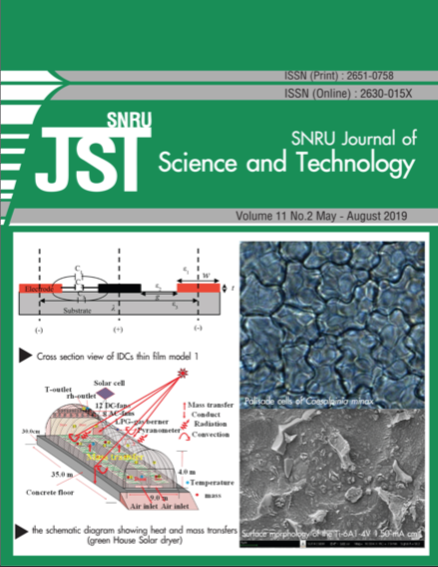The effect of low current density on the hydrophilicity and surface properties of the anodized films performed by two-step anodization
Keywords:
Hydrophilicity, Low current density, Two-step anodizationAbstract
The anodized films were performed by two step anodization. The main objective of this study was to investigate the effect of different low current density by two step anodization on the anodizing behavior, surface morphologies, surface roughness, surface species and hydrophilic property of the anodized films. The FESEM and AFM were used for the analysis of the surface morphology and roughness of the anodized films. The surface roughness was obtained after anodization. The XPS was used for study the surface species of the anodized films. The results showed that the OH group increased after anodizing process at low current density of 0.5 mA cm-2 in 1 M H3PO4 + 80% V/V C2H5OH. Hydrophilic property was measured by contact angle measurement. It was seen that the anodized films surface became hydrophilicity. Therefore, the increase in both OH groups and surface roughness could enhance the hydrophilicity to the anodized films, which are two important factors for improving osseointegration in order to apply to dental implant application.
References
[2] B. Li, J. Li, C. Liang, H. Li, L. Guo, S. Liu, H. Wang, Surface Roughness and Hydrophilicity of Titanium after Anodic Oxidation, Rare Metal Mat Eng. 45 (2016) 858-862.
[3] N. Masahashi, Y. Mizukoshi, H. Inoue, K. Ohmura, T. Moroishi, Photo-induced properties of anodic oxide on Ti–Pd alloy prepared in acetic acid electrolyte, J. Alloys Compd. 669 (2016) 91-100.
[4] H. Zhou, C. Wang, Z. Feng, S. Li, B. Xu, Formation of grid-like mesoporous titania film via structural transformation and its surface superhydrophilicity conversion, Surf. Coat. Technol. 207 (2012) 34-41.
[5] C. Demangel, D. Auzène, M. Vayssade, J.L. Duval, P. Vigneron, M.D. Nagel, J.C. Puippe, Cytocompatibility of titanium metal injection molding with various anodic oxidation post-treatments, Mater. Sci. Eng., C. 32 (2012) 1919-1925.
[6] B. Li, Y. Li, J. Li, Fu, X.C. Li, H. Wang, S. Liu, L. Guo, S. Xin, C. Liang, H. Li, Improvement of biological properties of titanium by anodic oxidation and ultraviolet irradiation, Appl. Surf. Sci. 307 (2014) 202-208.
[7] F.Y. Teng, I.C. Tai, M.W. Wang, Y.J. Wang, C.C. Hung, C.C. Tseng, The structures, electrochemical and cell performance of titania films formed on titanium by micro-arc oxidation, J. Taiwan Inst. Chem. Engrs. 45 (2014) 1331-1337.
[8] I.C. Chung, C.K. Chung, Y.K. Su, Effect of current density and concentration on microstructure and corrosion behavior of 6061 Al alloy in sulfuric acid, Surf. Coat. Technol. 313 (2017) 299-306.
[9] L. Zaraska, K. Gawlak, M. Gurgul, M. Dziurka, M. Nowak, D. Gilek, G.D. Sulka, Influence of anodizing conditions on generation of internal cracks in anodic porous tin oxide films grown in NaOH electrolyte, Appl. Surf. Sci. 439 (2018) 672-680.
[10] S. Periyasamy, M. Muthuchamy, Electrochemical oxidation of paracetamol in water by graphite anode: Effect of pH, electrolyte concentration and current density, J Environ Chem Eng. 6 (2018) 7358-7367.
[11] P. Wang, T. Wu, Y.T. Xiao, L. Zhang, J. Pu, W.J. Cao, X.M. Zhong, Characterization of micro-arc oxidation coatings on aluminum drillpipes at different current density, Vacuum. 142 (2017) 21-28.
[12] M. Kaseem, J.H. Min, Y.G. Ko, Corrosion behavior of Al-1wt% Mg-0.85wt%Si alloy coated by micro-arc-oxidation using TiO2 and Na2MoO4 additives: Role of current density, J. Alloys Compd. 723 (2017) 448-455.
[13] Z. Wu, M. Yoshimura, Investigations on procedures of the fabrication of barium titanate ceramic films under hydrothermal–electrochemical conditions, Solid State Ionics. 122 (1999) 161-172.
[14] P. Whangdee, S. Chukasorn, V. Srimaneepong, T. Watanabe, D.P. Kashima, Effects of Surface Roughness and Chemical Species on Hydrophilicity of Anodized Film on Ti-6Al-4V Formed at a Low Current Density, Adv. Mater. Res. 664 (2013) 774-779.
[15] S. Sriprasertsuk, P. Whangdee, S. Jinawath, P. Thunyakitpaisal, D.P. Kashima, Anodic Oxide Film Formed on Ti-6Al-4V at a Low Current Density in Monocalciumphosphate monohydrate (MCPM) Electrolyte and its Biocompatibility, Key Eng. Mater. 608 (2014) 212-217.
[16] E. Vermesse, C. Mabru, L. Arurault, Surface integrity after pickling and anodization of Ti–6Al–4V titanium alloy, Appl. Surf. Sci. 285 (2013) 629-637.
[17] D. Wei, W. Feng, Q. Du, R. Zhou, B. Li, Y. Wang, Y. Zhou, D. Jia, Titania nanotube/nano-brushite composited bioactive coating with micro/nanotopography on titanium formed by anodic oxidation and hydrothermal treatment, Ceram. Int. 41 (2015) 13115-13125.
[18] D.M. Brunette, P. Tengvall, M. Textor, P. Thomsen, Titanium in Medicine, Springer-Verlag Berlin Heidelberg, Germany, 2001.
[19] Z. B. Xia, H. Nanjo, H. Tetsuka, T. Ebina, M. Izumisawa, M. Fujimura, J. Onagawa, Crystallization of the anodic oxide on titanium in sulphuric acids solution at a very low potential, Electrochem. Commun. 9 (2007) 850-856.








